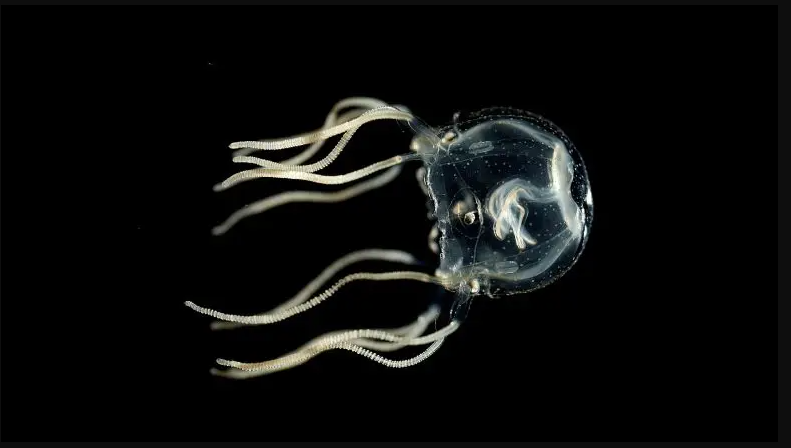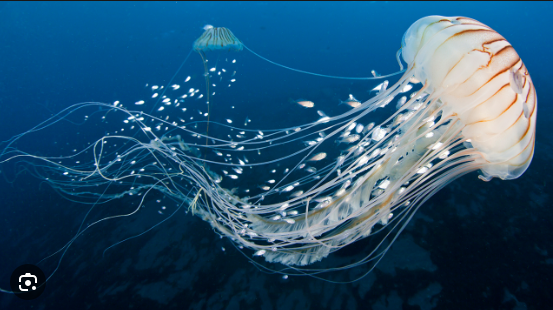Jellyfish defy conventional wisdom about how the brain learns by displaying sophisticated learning abilities comparable to those of humans and other complex creatures.
Learning Capabilities of Jellyfish: A Challenge to Neuroscientific Concepts
According to a new study published on September 22 in the journal Current Biology, jellyfish can learn from the past just like people, mice, and flies can. Tripedalia cystophora, a Caribbean box jellyfish, was trained to recognise and avoid hazards. The research disproves the idea that sophisticated learning needs a centralised brain and gives light on the evolutionary underpinnings of memory and learning.
Simple Creature with Complex Vision
These tiny jellies, which are about the size of a fingernail, actually feature a sophisticated vision system with 24 eyes embedded within their bell-shaped bodies. The animal, which inhabits mangrove swamps, uses its vision to navigate through murky waters and veer around submerged tree roots to catch prey. The capacity to avoid obstacles could be learned by the jellyfish through associative learning, which is the process by which living things make mental associations between sensory input and actions.

According to the initial author Jan Bielecki of Kiel University in Germany, learning is the nervous system’s highest level of performance. He claims that in order to teach jellyfish a new trick that will be effective, “it’s best to leverage its natural behaviours, something that makes sense to the animal, so it reaches its full potential.”
Simulated Learning Environment
Researchers painted a circular tank with grey and white stripes, the grey stripes resembling faraway mangrove roots, in an effort to mimic the jellyfish’s native habitat. For 7.5 minutes, they watched the jellyfish in the tank. The jelly first swam close to these seemingly distant stripes and frequently ran into them. The jelly, however, increased its average distance from the wall by nearly 50% by the conclusion of the trial, quadrupled the success rate of successful pivots to avoid collision, and reduced its contact with the wall by 50%. The results imply that jellyfish can acquire knowledge through mechanical and visual cues.
It’s usually a good idea to start out as simply as you can when trying to grasp complex structures, advises senior author Anders Garm of the University of Copenhagen in Denmark. We have a far higher chance of comprehending all the nuances and how it all works together to conduct behaviours when we look at these very rudimentary nerve systems in jellyfish.
Deciphering the Learning Center
The fundamental mechanism of jellyfish associative learning was subsequently sought after by the researchers by isolating the rhopalia, or visual sensory organs, of the species. These organs each contain six eyeballs and produce pacemaker signals that control the jellyfish’s pulsating motion. The frequency of the pulsing motion increases when the animal swerves away from danger.

The moving grey bars were displayed on the stationary rhopalium to simulate the animal’s approach to items. Light grey bars were perceived by the structure as being far away, and they had no effect. But when the researchers trained the rhopalium to respond to the light grey bars with modest electric stimulation, it began producing obstacle-dodging signals. These electrical impulses simulated the mechanical impulses produced by a collision. The results also demonstrated that the rhopalium functions as a learning centre and that associative learning in jellyfish requires the combination of visual and mechanical stimuli.
Future Directions
To further understand memory formation, the research team will next delve further into the cellular interactions of jellyfish nervous systems. To get a full picture of the animal’s associative learning, they also intend to learn more about how the mechanical sensor in the bell functions.
It’s amazing how quickly these creatures pick things up; they learn at roughly the same rate as more advanced species, adds Garm. Even the most basic nervous system appears to be capable of advanced learning, which may be the result of a very basic cellular process developed at the beginning of the evolution of the nervous system.
TO KNOW MORE: The Surprising Intellect of Jellyfish Changes Our Fundamental Understanding of the Brain.
ALSO READ:Feeding The World: 6.5% Of The World’s Grain Production Is Contributed By Earthworms




































